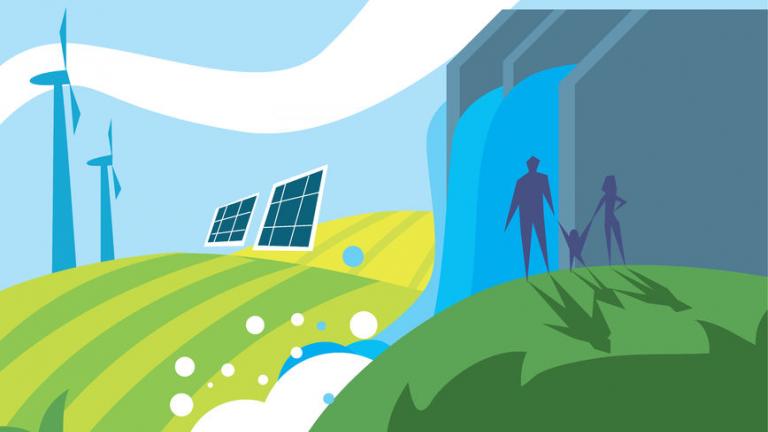
Energy is a key indicator of a developing nation's overall industrial as well as economic and social development. With the meteoric rise of the metropolis and improved municipal plans, Bangladesh is also having thousands of ongoing and incoming development projects coupled with the prospective energy surge. The mechanical process of development including transportation, industrial, real states, residential and commercial projects stakes for power-hungry energy consumption.
The majority of these development projects use petroleum and gas in Bangladesh. Additionally, the Bangladesh Government has two major footsteps to make by 2021: Middle-Income country with electricity for all. This surge of development requires addressing infrastructural development requiring again massive energy resource. This is causing a rapid depletion of the global mineral core. If the global consumption continues at the current rate, energy & minerals will be completely depleted by 2088; when oil, gas, and coal will run out respectively by 2051, 2061 and 2081.
Other than a moderate natural gas reserve, Bangladesh has a little hold of oil and coal. However, like many countries, Bangladesh shares the growing concern of fossil fuel depletion at an alarming rate. Along with this, global warming has taken Bangladesh to an inflection point. Again, the continuation of off-grid power supply with uninterrupted industrialization requires secured energy flow regardless of source or provision.
This paradoxical situation requires addressing one pivotal topic: the required energy source of Bangladesh. Should Bangladesh be moving towards alternative energy sources and if yes, how far it has come? This further generates another question: what can be the ideal energy mix?
Fossil Fuels
Petroleum is one of the most demanding yet impoverished energy sector in Bangladesh. Each year, Bangladesh imports more than five million tonnes of oil. In 2016, for example, the government plans to import 13 lakh tonnes of crude oil worth 553 million dollars, putting inflationary pressure on the economy. The latest and only oil field in Sylhet amounts to only 153 million barrels. This reserve once drilled, will meet the current demand at the current consumption rate only for 2 years.
Although there is a sizeable gas stock in Bangladesh, if the current extraction rate continues, this reserve will dry up by 2031. On the other hand, Bangladesh hit an energy mother lode when it won 20,000 square kilometers of natural-gas-rich water line from India in a U.N. territorial arbitration in July 2014. However, this might not bear fruit immediately. However, the area is highly expensive to excavate and the Bangladesh government has shown little interest in spending on immediate energy infrastructure. Two bidders from Indian and U.S energy corporations have knocked PetroBangla to operate in this 200 trillion cubic feet gas reserve area. Once ran, this largest supply in the Asia-Pacific will take Bangladesh to a whole new level.
The coal sector in Bangladesh occupies only 2% of total energy generation as of 2015. The Power Sector Master Plan (PSTM 2010) targets above 50% of total generation (21.71% from imported and 29.07% from domestic coal) by 2021. The ambitious shift is easily justifiable. The explored regions with coal potential hold an estimated 3 billion tonnes reserve which can serve energy demand for 50 years, considering 15% system loss during extraction. However, principal barriers for such operation are technical and environmentally friendly mining methods. These barriers even make the proposed 30 projects and plants on hold or inoperable at least before 2019.
These depleting mediums raise the need for a secondary energy source. Considering the present energy mix vs. plan for LNG, Coal, renewable & EE sector, we have a very promising prospect for investment. However, for a feasible alternative source, we have two options: nuclear energy and renewable energy.
Secondary Energy Sources
The nuclear energy source is still a newborn in Bangladesh. The only project is the proposed Rooppur Nuclear Power Plant, with dual stations (1,200 MWe ~ 3,000 MWth). Although the technical assistance will come from Russian Rosatom State Atomic Energy Corporation, the installation cost is projected to be a budget overrun (12.65 billion dollars excluding a 4% interest rate). The flat-out project is also high in risk profile in terms of technical complexity and maintenance. Such a Russian contract in other countries had proved to be time and cost overdue. In Iran, for example, a German-Russian contact took 39 years (1974-2013) to install a 1,000 MWe VVER plant. Started by following a wishy-washy approach about public consultation, this project if installed by the targeted timeframe, will be operational after 2023. So Nuclear energy is not an immediate answer for a secondary energy source.
This leaves us with another choice: renewable energy. This energy source, however, is still nascent in Bangladesh. The total energy source although primarily depends on conventional energy sources, Renewable Energy Policy 2009 of Bangladesh targets 5% of total energy production to be achieved by 2015 and 10% by 2020, while the share of Renewable Energy exceeds only 1% till now.
Although Bangladesh is crisscrossed with many rivers, there are very few torrential rivers to house hydroelectric plants. Karnaphuli Power Station is the only plant in Bangladesh that generates 230 MW of electricity. As Chittagong Hill Tracts (CHT) offer Mountain Rivers with a strong current, more hydroelectric plants can be initiated in this region to mitigate the demanding electricity gap. A Power Cell supervised study also suggests two rivers from this area: the Sangu River with a potential of 58.33 MW and the Matamuhuri River with 20.83MW power. With a target to increase the capacity, the Bangladesh government also plans to invest 1 billion USD to install a hydro-electricity power company. Aside from electricity generation, this plant will be able to import electricity from hydropower plants from high altitude countries, i.e., Bhutan and Nepal.
A coastline supply of renewable energy can be the wind source. Due to wind energy’s limited circulation to off-shore islands, riverine and other inland open areas with a strong wind regime, the southern part of Bangladesh can be brought under this source. To generate electricity from wind energy, Bangladesh Power Development Board (BPDB) has installed a total of 1,900 kW grid capacity at Feni and Kutubdia island. Another 50-200 MW at Parky Beach is under planning.
The most promising renewable source can be solar energy. With an ambitious plan of being the world’s ‘first solar nation’. Bangladesh Solar and Renewable Energy Association (BSREA) is assisting the Bangladeshi government to provide electricity to all by 2021. Side by side, Infrastructure Development Company Limited (IDCOL) initiated Solar Home System (SHS) program in 2003 and till 2016 it has installed solar power in 4.5 million households, reaching 18 million people. Through this SHS program and similar utility-scale applications, the government targets to achieve ‘Vision 2021’ with 1.7GW of solar capacity.
But transition is not always easy. Bangladesh’s historic milieu makes the process more difficult. Nevertheless, mass consideration and public policy landscape are changing. The move towards alternative energy is coming from other directions as well. Although lately adopted, people are moving from oil-run vehicles to muscle-pulled two-wheelers. These riders, most of whom are young people, are terming bicycles “ride for the environment” as an eponym. This growing consciousness is enabling less use of depleting energy and saving the environment.
To save the ardent electricity crisis, the Rural Electrification Board (REB) introduced the “Efficient Lighting Initiatives of Bangladesh (ELIB)” program in early 2009. Under this project, people from 1,400 rural and urban households voluntarily brought in their incandescent bulbs to exchange with new Compact Fluorescent Lamps (CFLs). On June 19th, 2010, this project hit a world record of collectively installing about five million energy-saving CFL bulbs.
What can Bangladesh do?
As much as we talk about green energy and 100% renewable energy, we cannot shift overnight nor can Bangladesh depend on a single source of energy – at least not yet. As both renewable and non-renewable sources have their limitations, it is best to use different sources with maximum strength in their respective usage areas.
- Gas being the primary energy source, the uncharted area in the Bay of Bengal can be the best option for the exploration of further reserve. If the massive energy mother lode is extracted, alongside meeting indigenous demand, Bangladesh can start energy trading and presumably be the Asian Energy Superpower.
- The majority of the potential Micro-Hydro sites in Bangladesh are located in the Chittagong Hill Tracts (CHT). However, establishing micro-hydro units requires the utilization of hydropower and indigenous technical capabilities to utilize the existing momentums. The government should decentralize the micro-hydro units with local implementation and management. These planned hydroelectricity and micro-hydro projects will be another source to overcome the chronic load-shedding problem in CHT. Additionally, the self-reliance and the use of local resources will have a notable impact on the development of remote tribal areas.
- Energy need for shoreline areas in southern Bangladesh can be covered by adopting wind power. The geographical spread may be from Feni to Cox’s Bazar. Natural disasters in coastal areas and over and under the speed of wind are two major problems for wind power. The government should proceed for proper wind speed calculation and wind mapping.
- Off-grid and rural areas are the most suitable options for solar power applications. This potential power source can mitigate the under-addressed areas when natural gas and coal power can be solely used for industrialization purposes and city needs. But it is difficult for Bangladesh to implement a grid-connected solar system as it will create disturbance in the current network of PGCB because of the unpredictability of the power. Mega disturbance, battery replacement issues, power shortage, and outage are some of the technical obstacles to install mega RE plants in Bangladesh. As the solar is subjected to sunlight, there will be no power at night which will create a sudden shortage.
- Land scarcity is a major obstacle for both solar and wind power plant installation. Hence, a trade-off between land for cultivable crop and RE plants is a critical decision for the government.
- The absence of a tariff structure is another major barrier for both technology types which discourages the private investors to invest in the uncertain nature of wind and power energy. To address this case, private investment for the RE plants should follow a competitive bidding process, i.e., instrument competitive business model.
If adopted, these recommendations can serve as a reference point for future roadmaps of the national energy mix. The first world countries are experimenting with unorthodox forms of renewable energy for sustainable growth and eco-friendly potential. A developing country like Bangladesh should at least adopt the mainstream technologies of renewable energy after careful analysis of the national energy mix.






